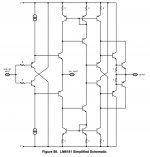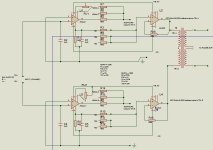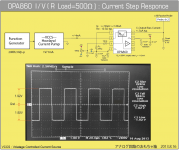Seeing as you mentioned my CFB I/V stage that's going to be put on a PCB by Matt Garman over the next few weeks (Matt's schedule permitting) along with a couple of TDA1387 chips so a very low cost DAC core can be built. Everything will be open sourced.
Interested to see that CFB I/V when available
here Is a high quality discrete I/V for balanced PCM1704
PCM1704 DAC - strona 38 - DIY - Audiostereo.pl - strona 38
you can see 3 stages
here Is a high quality discrete I/V for balanced PCM1704
PCM1704 DAC - strona 38 - DIY - Audiostereo.pl - strona 38
you can see 3 stages
Seeing as you mentioned my CFB I/V stage that's going to be put on a PCB by Matt Garman over the next few weeks (Matt's schedule permitting) along with a couple of TDA1387 chips so a very low cost DAC core can be built. Everything will be open sourced.
any update ?
I'll let Matt chip in if he's got something to share. For myself I'm moving away from TDA1387 being my prime DAC chip of choice as I think I've found something better and surprisingly its not multibit - for details go have a look at my blog. Its a considerably more complex and power-hungry solution though so for portable low power applications I reckon TDA1387 will still be king for some time.
The LM6181 to me (which isn't much) looks good also on paper, but it doesn't have the magic TZ (pin 5) that the AD844 has that allows one to use it without feedback.
I feel this is one of the reasons the AD844 sounds so good. It's as though feedback in an I/V stage is a big no no, as it can get corrupted with all the HF glitches and stuff comming out of the dac chips. Please correct me if I'm wrong all you I/V aficionados that know better than I do? Because I'm going more on what's sounding better, rather than what's measuring better.
Cheers George
I saw the LM6181 in Farnell, popped up sidse to side with the AD844.
Indeed the TZ pin is missing.
- Pedja inputs in his discrete configuration to the inverting input. The compensation is on the input (1,8 nF). So this configuration might be possible with LM6181 too imho. Specswise: The inverting input current capability of 15 mA looks promising - quite a quantum leap over the AD844's 800 uA.
Attachments
I have a Raindrop-hui dual 1541A dac reconfigured for differential working by the simple, although not perfect, method of supplying one dac with inverted data.
For the last few years I have used 100r + Sowter 9545 transformers to perform IV and convert to single ended output.
Running in NOS mode with the (SAA7220 removed) with no other filtering I am always drawn back to this dac compared to an Audio Note Dac 1 (AD1865), an ES9018 Sabre dac and a Teac PD H01 with a PCM5102 dac.
So after reading the posts in this thread I am tempted to use 4, AD844 ( 1per dac output) with (1-2n on pin 2) for IV, with pin 6 driving the transformer, 1k//470pf on pin 5.
As the primaries will be connected between the True and Inverted outputs, the 1541's 2ma offset can be ignored provided I can adjust the 844 outputs to the same value so no DC flows through the transformer. Does that sound feasible?
The next step is to connect ADEL2020s to the tz outputs and compare. (I'm not convinced a micropower opamp like the OPA627 will be ideal for driving the transformer).
Finally, stacked 844s, again comparing pin 6 with pin 5 buffered with the 2020s.
Ian
For the last few years I have used 100r + Sowter 9545 transformers to perform IV and convert to single ended output.
Running in NOS mode with the (SAA7220 removed) with no other filtering I am always drawn back to this dac compared to an Audio Note Dac 1 (AD1865), an ES9018 Sabre dac and a Teac PD H01 with a PCM5102 dac.
So after reading the posts in this thread I am tempted to use 4, AD844 ( 1per dac output) with (1-2n on pin 2) for IV, with pin 6 driving the transformer, 1k//470pf on pin 5.
As the primaries will be connected between the True and Inverted outputs, the 1541's 2ma offset can be ignored provided I can adjust the 844 outputs to the same value so no DC flows through the transformer. Does that sound feasible?
The next step is to connect ADEL2020s to the tz outputs and compare. (I'm not convinced a micropower opamp like the OPA627 will be ideal for driving the transformer).
Finally, stacked 844s, again comparing pin 6 with pin 5 buffered with the 2020s.
Ian
It's a current conveyor - the current going into pin 2 is coming out from pin 5, unchanged. The voltage at pin 2 sets the DC output offset.
This part is really much easier to use than an opamp!
BTW for paralleling, you should also // pin 5 on the devices as that will lower the offset between the buffered outputs so lowering chance for equalizing currents. You can then use a single load resistor on the // pin 5's and don't need the 100 ohms as Calvin noted.
BTW Anybody here ever experimented with using pin 5 as an input? Opens up all kinds of interesting circuits...
Edit: for the not faint at heart: check out http://linearaudio.nl/sites/linearaudio.net/files/UK-1 2008040241.pdf (fig 7) and http://linearaudio.nl/sites/linearaudio.net/files/UK-2 2008050441.pdf (fig 4) ;-)
Jan
Jan, I had a look at your PAX circuit, and see that you have pin 3 and 5 connected as input. Because 5 mirrors the current at 3 (i read somewhere) this does puzzle me a lot. (heb ik zaagsel in het hoofd?)
albert
I have a Raindrop-hui dual 1541A dac reconfigured for differential working by the simple, although not perfect, method of supplying one dac with inverted data.
For the last few years I have used 100r + Sowter 9545 transformers to perform IV and convert to single ended output.
Running in NOS mode with the (SAA7220 removed) with no other filtering I am always drawn back to this dac compared to an Audio Note Dac 1 (AD1865), an ES9018 Sabre dac and a Teac PD H01 with a PCM5102 dac.
So after reading the posts in this thread I am tempted to use 4, AD844 ( 1per dac output) with (1-2n on pin 2) for IV, with pin 6 driving the transformer, 1k//470pf on pin 5.
As the primaries will be connected between the True and Inverted outputs, the 1541's 2ma offset can be ignored provided I can adjust the 844 outputs to the same value so no DC flows through the transformer. Does that sound feasible?
The next step is to connect ADEL2020s to the tz outputs and compare. (I'm not convinced a micropower opamp like the OPA627 will be ideal for driving the transformer).
Finally, stacked 844s, again comparing pin 6 with pin 5 buffered with the 2020s.
Ian
Couldn't edit my earlier post. Attached provisional schematic.
The pin 5 resistors have been reduced to 220r to reduce the voltage swing across the transformer, may need reducing further as the transformer is not 1:1. I think I'm correct in saying that the no signal volts on the tz pin will be approx .44v so provided both + & - outputs are close, DC flowing through the transformer will not be an issue. (ignore the blue line)
Attachments
Same here! I'll run some spice simulations to see if it works at all. Whether it sounds good or not, only real-life listening session will tell us 😎I saw the LM6181 in Farnell, popped up sidse to side with the AD844.
Unfortunately LM6181 lacks the "TZ" output, where the actual IV resistor should be connected 🙁
Unfortunately LM6181 lacks the "TZ" output, where the actual IV resistor should be connected 🙁
I've searched everywhere for an "opamp" that can be used with "no feedback" and high slew rate of 2000v/us, that also has a TZ output, and couldn't find one. The Barry Gilbert designed AD844 is unique in this regard.
Cheers George
Member
Joined 2006
Is there really a need for such an I/V resistor? 😀
Like in the LM and EL chips mentioned, perhaps tying a R1 to the non inverting input and ground, and place a R2 from output to ground will do...
Amplication factor is the chip transimpedance x input current and the ratio of R1 and R2... yes? (^V^)
Like in the LM and EL chips mentioned, perhaps tying a R1 to the non inverting input and ground, and place a R2 from output to ground will do...
Amplication factor is the chip transimpedance x input current and the ratio of R1 and R2... yes? (^V^)
Is there really a need for such an I/V resistor? 😀
Like in the LM and EL chips mentioned, perhaps tying a R1 to the non inverting input and ground, and place a R2 from output to ground will do...
Amplication factor is the chip transimpedance x input current and the ratio of R1 and R2... yes? (^V^)
🙂
Member
Joined 2006
CFT, if you use the "classical" wiring of the Op Amp you won't have the "no-feedback" solution anymore 😀
Member
Joined 2006
I've searched everywhere for an "opamp" that can be used with "no feedback" and high slew rate of 2000v/us, that also has a TZ output, and couldn't find one. The Barry Gilbert designed AD844 is unique in this regard.
I thought I was educated, obviously not I could be wrong.
Other than 861 and the 844 having discrete buffers, different pin layouts, and Iq control not being on the 844 whats different now?
Ignoring that neither are designed to run OL in the first place, what makes you think other current-amps with sectioned buffer can't be used as you describe?
Previous to your question I thought there were only two distinct categories; designs with accessible current mirror sections or designs w/o. (discrete buffer or w/o)
So unless 844 does in fact deserve it's own (new) category then your question is confusing. I did think the significance of the 844 was early access to the current conveyor without interaction from the buffer at first. i.e. they're sectioned off, but then I discovered the 861 to also have this perk, so now I'm confused what the fuss is about.
Btw I asked a similar question earlier, to which calvin replied;
Pin 5 of the OPA860 (typo?) is the Input to its buffer ... in that it equals the AD844
Could it be that sectioned areas are externally accessible on both but one has the connections separate in/out on two pins, rather than in/out on one conjoined pin?
Last edited:
Hi,
no typo! The OPA860 comes with buffer, the OPA861 without.
In contrast to the AD844 the OPA860s buffer input (pin5) is fully separated from the current conveyor output (pin8).
The TZ pin (pin5) of the AD844 is the common joint of the current conveyor output and the buffer input.
From the DS the OPA860/861 are the better performers with lower input resistance at the "Emitter" input and higher and tuneable bias current.
They are good for ~2.5Vrms of signal output voltage running on +-5V supplies.
Adding a external discrete Buffer to either of them -You know which one I would recommend 😉 - offers higher flexibility regarding load requirements and acoustic performance.
jauu
Calvin
no typo! The OPA860 comes with buffer, the OPA861 without.
In contrast to the AD844 the OPA860s buffer input (pin5) is fully separated from the current conveyor output (pin8).
The TZ pin (pin5) of the AD844 is the common joint of the current conveyor output and the buffer input.
From the DS the OPA860/861 are the better performers with lower input resistance at the "Emitter" input and higher and tuneable bias current.
They are good for ~2.5Vrms of signal output voltage running on +-5V supplies.
Adding a external discrete Buffer to either of them -You know which one I would recommend 😉 - offers higher flexibility regarding load requirements and acoustic performance.
jauu
Calvin
- Home
- Source & Line
- Digital Line Level
- Using the AD844 as an I/V


